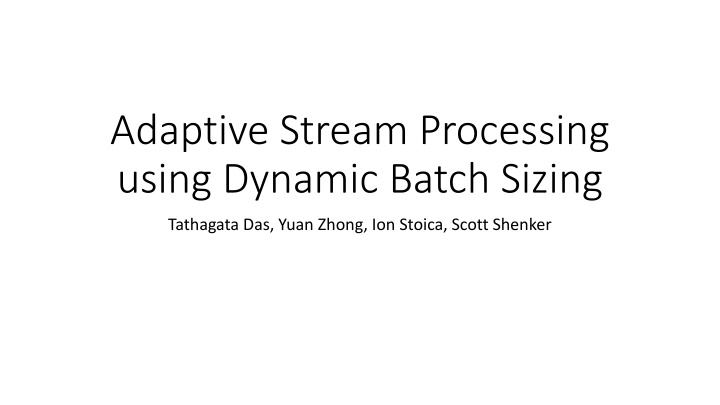
Dynamic Batch Sizing and Stream Processing Insights
Explore the world of adaptive stream processing, dynamic batch sizing, and latency reduction strategies in this informative collection of visual content and explanations. Learn about key concepts such as batch intervals, system stability, and control module behavior to enhance your understanding of managing changing workloads effectively.
Download Presentation

Please find below an Image/Link to download the presentation.
The content on the website is provided AS IS for your information and personal use only. It may not be sold, licensed, or shared on other websites without obtaining consent from the author. If you encounter any issues during the download, it is possible that the publisher has removed the file from their server.
You are allowed to download the files provided on this website for personal or commercial use, subject to the condition that they are used lawfully. All files are the property of their respective owners.
The content on the website is provided AS IS for your information and personal use only. It may not be sold, licensed, or shared on other websites without obtaining consent from the author.
E N D
Presentation Transcript
Adaptive Stream Processing using Dynamic Batch Sizing Tathagata Das, Yuan Zhong, Ion Stoica, Scott Shenker
Batched stream Processing Batch interval Size of the batch in seconds Examples: Comet, Spark Streaming - Run streaming computations as a number of short, deterministic batch jobs - Spark- State between batches kept in memory as Resilient Distributed Datasets
Latency = Batching delay + Queueing delay + Processing time Lower batch intervals lead to lower latency Stability- batch processing time must not exceed the batch interval Stability Condition Line
Static batch intervals- Offline Learning Limitations Specific to cluster resources Unpredictable changes in incoming data rates hard to model
The Control Module Control Module Learns behaviour of the system to decide batch interval Desirable Properties Low Latency Agility Generality Ease of Configuration
Dynamic Batch Sizing Goals - Achieve minimum batch interval - Ensure system stability - Speed - Adapt to changing workloads
Early Solutions Controls based on Binary Signals Controls based on Gradient information - Large Gradient- Reduce the batch interval by a configured step size - Small Gradient- Increase or decrease the batch interval based on operating point
Fixed Point Iteration Relaxing the requirements Batch intervals chosen based on the intersection between workload function (x) and the condition line batch processing time=px batch size and p<1
Type I intersections - Find a point x* such that (x*) = px Type I intersection is reduced to solving the fixed point function f(x) = (x) /p such that f(x*) = (x*) /p = x* Start with an initial guess x1 Iterate using xn+1 = f(xn) = (x*) /p for n=1,2, - Converges quickly
Type II intersections Condition: (x1) /x1 < (x2) /x2 (x1) > px1 and (x2) > px2 Next batch interval Xn+1 = (1-r) x min (x1, x2)
- Checking Type II inconclusive if the batch intervals of the last 2 completed jobs are the same - Principle of slow start - Algorithm does not converge if Type I intersection does not exist
System Architecture Adaptive window based aggregation
Evaluation 20 m1.x large EC2 instances p= 0.7 r = 0.25 High vale of p = Greater robustness, Larger batch intervals High value of r = Quick Type I Convergence
Comparisons with static batch intervals Static data rates Time varying data rates Comparison of the end-to-end latency observed with static and time-varying data rates and static/dynamic batch intervals
Reduction in queueing delay - Sinusoidal input data rate between 1 and 6.4 MB/s Static batch interval = 1.3 s Queueing delay starts building up - - Dynamically adapting batch size Reduction in end to end latency -
Changing workloads - - - Reduce workload Constant data rate 6MB/s Number of keys varied between 500 and 40000
Resource Variations - cluster resources Background jobs consuming 25% of the Timeline of batch interval and other times for the reduce workload under variations in the available workload
Comments + No prior knowledge of the workload + Ability to adapt to a varying number of workloads + Achieves low latency, agility and ease of configuration + No modifications required to the programming interface - The control loop introduces an overhead - Failure of the control module - Slow start/ Initial parameters - Batching strategy for lost streams and sudden unexpected spikes?
Discussion/Questions Possible challenges when applied to the continuous operator model?
